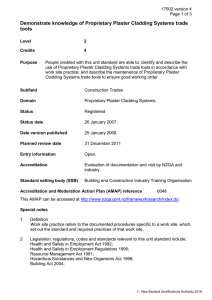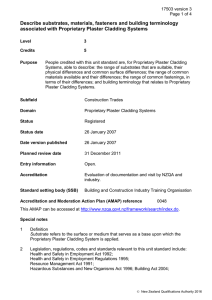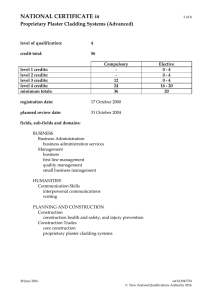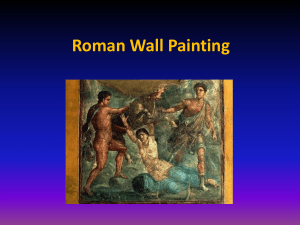Explain product knowledge and technical information for Proprietary Plaster Cladding Systems
advertisement
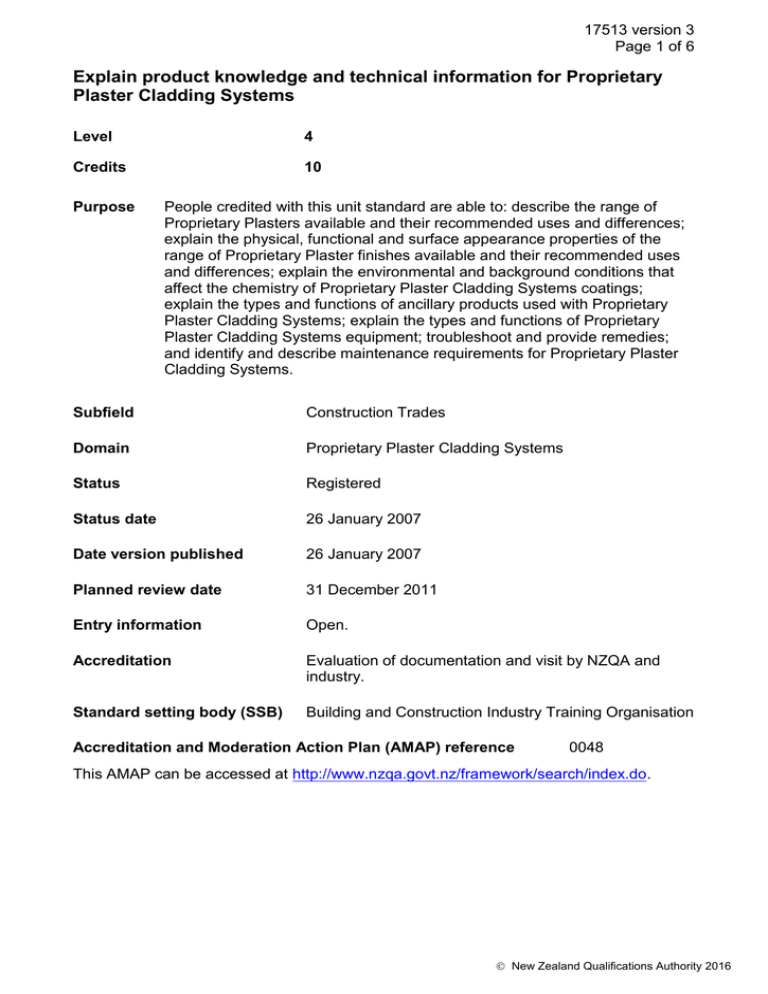
17513 version 3 Page 1 of 6 Explain product knowledge and technical information for Proprietary Plaster Cladding Systems Level 4 Credits 10 Purpose People credited with this unit standard are able to: describe the range of Proprietary Plasters available and their recommended uses and differences; explain the physical, functional and surface appearance properties of the range of Proprietary Plaster finishes available and their recommended uses and differences; explain the environmental and background conditions that affect the chemistry of Proprietary Plaster Cladding Systems coatings; explain the types and functions of ancillary products used with Proprietary Plaster Cladding Systems; explain the types and functions of Proprietary Plaster Cladding Systems equipment; troubleshoot and provide remedies; and identify and describe maintenance requirements for Proprietary Plaster Cladding Systems. Subfield Construction Trades Domain Proprietary Plaster Cladding Systems Status Registered Status date 26 January 2007 Date version published 26 January 2007 Planned review date 31 December 2011 Entry information Open. Accreditation Evaluation of documentation and visit by NZQA and industry. Standard setting body (SSB) Building and Construction Industry Training Organisation Accreditation and Moderation Action Plan (AMAP) reference 0048 This AMAP can be accessed at http://www.nzqa.govt.nz/framework/search/index.do. New Zealand Qualifications Authority 2016 17513 version 3 Page 2 of 6 Special notes 1 Definition Specifications refers to documented instructions (oral, written, graphic) and may include any of the following: manufacturer’s specifications, recommendations or technical data sheets; material specifications; specifications from a specialist source such as an architect, designer, engineer or a supervisor; site or work specific requirements. 2 Legislation, regulations, codes and standards relevant to this unit standard include: Health and Safety in Employment Act 1992; Health and Safety in Employment Regulations 1995; Resource Management Act 1991; Hazardous Substances and New Organisms Act 1996; Building Act 2004; New Zealand Standards, NZS 4218:2004 Energy efficiency – Small building envelope and NZS 3604:1999 Timber Framed Buildings, available from Standards NZ (http://www.standards.co.nz); New Zealand Building Code; Territorial Authorities’ building regulations. Elements and performance criteria Element 1 Describe the range of Proprietary Plasters available and their recommended uses and differences. Performance criteria 1.1 Proprietary Plasters are identified and described in relation to the types of coatings. Range 1.2 Proprietary Plasters are identified and described in relation to their production or modification. Range 1.3 factory mixed, site mixed, site modified. Proprietary Plasters are identified and described in terms of their physical properties and applications. Range 1.4 cement based, polymer based. lightweight, heavyweight, thick, thin, rigid, flexible, curing characteristics. The reinforcements used with selected Proprietary Plaster coatings are identified and described according to the coatings selected. Range integral fibre reinforcement, mesh reinforcement. New Zealand Qualifications Authority 2016 17513 version 3 Page 3 of 6 1.5 Reinforcement material used with selected Proprietary Plaster is identified and described according to type. Range fibreglass, plastic, cellulose. Element 2 Explain the physical, functional and surface appearance properties of the range of Proprietary Plaster finishes available and their recommended uses and differences. Performance criteria 2.1 Proprietary Plaster finishes are identified and described in accordance with manufacturer’s specifications and job requirements. Range 2.2 Different Proprietary Plaster finishes are identified and described in terms of applications and limitations. Range 2.3 coloured paint, coloured plaster, coloured cement, lime wash. The maintenance of Proprietary Plaster finishes is explained in terms of processes applied. Range 2.6 applied by – trowel, spray, roller, brush, sponge. Proprietary Plaster finish options in terms of how colour is achieved, are identified and described in accordance with manufacturer’s specifications and job requirements. Range 2.5 weatherproof, maintainability, fire resistance properties, life expectancy, abrasion resistance, sound transmission, impact resistance, vapour permeable, flexibility. Proprietary Plaster textures are identified and described in terms of the way they are created, applied and finished. Range 2.4 paint, glaze, elastomeric, highbuild, polymer plaster, cement plaster, lime wash, cement wash. inspection, resealing, recoating, washing, chemical cleaning, repairing. Proprietary Plaster finishes are explained in terms that relate to colour and colour variances. Range opacity, light reflectance value, intensity, gloss levels, tones. New Zealand Qualifications Authority 2016 17513 version 3 Page 4 of 6 Element 3 Explain the environmental and background conditions that affect the chemistry of Proprietary Plaster Cladding Systems coatings. Performance criteria 3.1 Background conditions for Proprietary Plaster Cladding Systems coatings are explained in terms of impact. Range 3.2 Weather and environmental effects on the application and curing of Proprietary Plaster Cladding Systems coatings are explained. Range 3.3 suction, cleanliness, surface friability, dampness, surface chemical contamination, surface drumminess. temperatures, wind effect, humidity, shade, background moisture content. The architectural or designer properties of different Proprietary Plaster Cladding Systems are explained. Range fire resistance rating, flame spread, insulation, wind loading, sound transmission, impact resistance, aesthetic limitations. Element 4 Explain the types and functions of ancillary products used with Proprietary Plaster Cladding Systems. Performance criteria 4.1 The different types of flashings used in conjunction with Proprietary Plaster Cladding Systems are identified and described in terms of their functions and suitability. Range 4.2 The different types of proprietary fastenings and adhesives used with Proprietary Plaster Cladding Systems are identified and described in terms of their functions and suitability. Range 4.3 sill, jamb, corner, junction expansion, head, base, parapet, saddle. nails, screws, washers, insulation anchors (darts), adhesives, modified plaster. The different types of bead sealants and joint fillers used with Proprietary Plaster Cladding Systems are identified and described in terms of their function, suitability and limitations. Range cartridge sealants, expanding foam, backing bead. New Zealand Qualifications Authority 2016 17513 version 3 Page 5 of 6 4.4 The correct measurement, mixing and use of additives with Proprietary Plaster Cladding Systems is explained. Range 4.5 polymer additions, oxide pigments, tinter pigments, fibres, clean tempering water. The selection, limitation and application of masking products for use with Proprietary Plaster Cladding Systems are identified and described in accordance with manufacturer’s specifications and job requirements. Range paper masking, plastic masking, PVC tape, cloth tape, paper tape, tape primer. Element 5 Explain the types and functions of Proprietary Plaster Cladding Systems equipment. Performance criteria 5.1 The different types of mixing equipment used with Proprietary Plaster Cladding Systems are identified and described in accordance with manufacturer’s specifications and job requirements. Range 5.2 The different types of special application equipment used with Proprietary Plaster Cladding Systems are identified and described in accordance with manufacturer’s specifications and job requirements. Range 5.3 stirrers, paddle mixers, continuous mixers. pressure pots, pumps, hot groover knives, spray guns, hopper guns. The different types of special finishing equipment used with Proprietary Plaster Cladding Systems are identified and described in accordance with manufacturer’s specifications and job requirements. Range plastic floats, stainless steel trowels, wood floats, polyethylene floats, polystyrene floats, texture rollers, lacing rollers, sponges. Element 6 Troubleshoot and provide remedies. Performance criteria 6.1 Causes and remedies for variations in finishes are identified and described in terms of the impact on desired job outcomes. Range colour, cold joints, texture, flatness. New Zealand Qualifications Authority 2016 17513 version 3 Page 6 of 6 6.2 Causes and remedies for failures in Proprietary Plaster Cladding Systems are identified and described in terms of the impact on desired job outcomes. Range cracking, delamination, impact resistance, leaks. Element 7 Identify and describe maintenance requirements for Proprietary Plaster Cladding Systems. Performance criteria 7.1 Maintenance requirements for Proprietary Plaster Cladding Systems are identified and described in accordance with manufacturer’s instructions. Range cleaning, ground/deck clearance, landscaping considerations, sealant maintenance, crack and damage repair, repainting. Please note Providers must be accredited by the Qualifications Authority, or an inter-institutional body with delegated authority for quality assurance, before they can report credits from assessment against unit standards or deliver courses of study leading to that assessment. Industry Training Organisations must be accredited by the Qualifications Authority before they can register credits from assessment against unit standards. Accredited providers and Industry Training Organisations assessing against unit standards must engage with the moderation system that applies to those standards. Accreditation requirements and an outline of the moderation system that applies to this standard are outlined in the Accreditation and Moderation Action Plan (AMAP). The AMAP also includes useful information about special requirements for organisations wishing to develop education and training programmes, such as minimum qualifications for tutors and assessors, and special resource requirements. Comments on this unit standard Please contact the Building and Construction Industry Training Organisation national.office@bcito.org.nz if you wish to suggest changes to the content of this unit standard. New Zealand Qualifications Authority 2016
